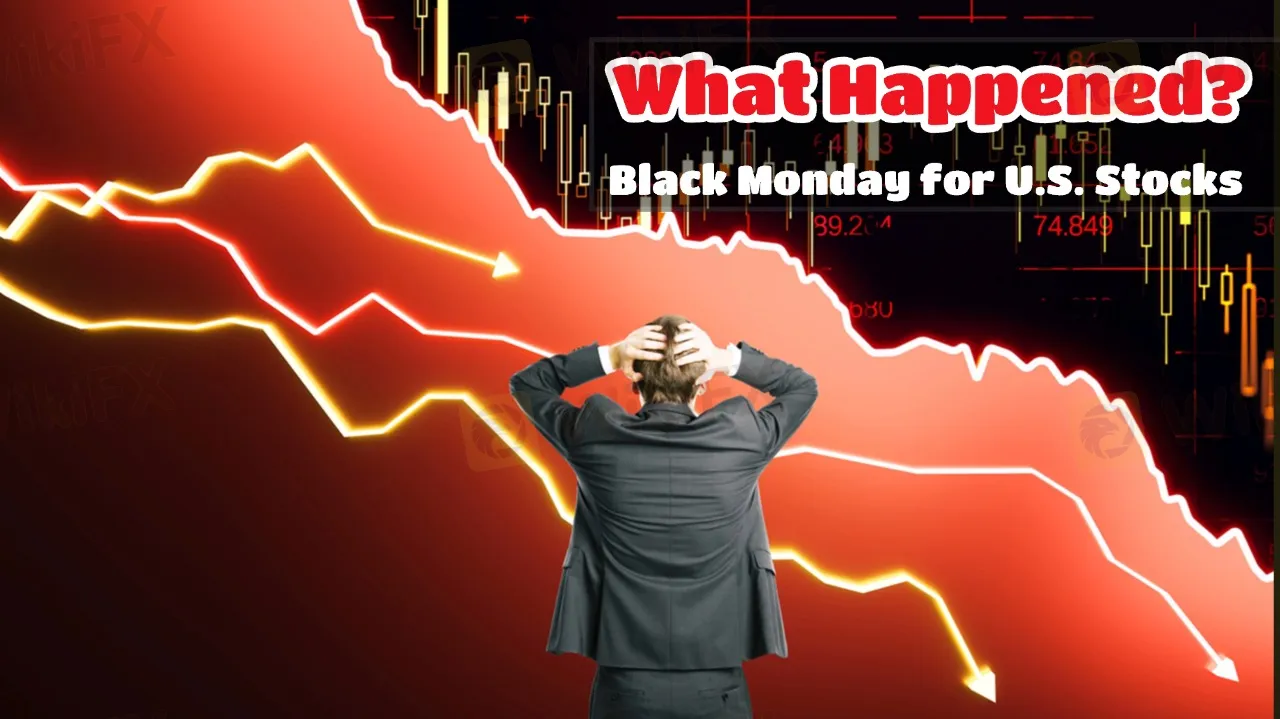简体中文
繁體中文
English
Pусский
日本語
ภาษาไทย
Tiếng Việt
Bahasa Indonesia
Español
हिन्दी
Filippiiniläinen
Français
Deutsch
Português
Türkçe
한국어
العربية
Black Monday for U.S. Stocks: What Happened?
Abstract:The U.S. stock market suffered another major blow, with all three major indices tumbling and tech giants losing over $830 billion in market value. Market panic intensified, recession concerns escalated, and the Federal Reserve’s policy direction became a key focus.

Following last weeks sharp sell-off, U.S. stocks faced another “Black Monday.” All three major indices opened lower and continued to decline throughout the day. The S&P 500 dropped more than 3% intraday, the Nasdaq plunged over 4%, and the Dow Jones Industrial Average fell nearly 1,190 points at its lowest, closing down 2.1%.
By the end of the session, the Nasdaq had posted a 4% loss, marking its worst single-day decline since September 2022, while the S&P 500 fell 2.7%.
Tech stocks were hit particularly hard. The “Magnificent Seven,” including Nvidia, Microsoft, and Apple, all fell more than 2%. Tesla suffered an even steeper drop of over 15%, marking its biggest single-day decline since 2020. In total, the seven tech giants lost over $830 billion in market value, setting a record for the largest single-day loss.
Why Did U.S. Stocks Plummet?
Analysts widely attribute the sell-off to comments made by former President Donald Trump, which heightened investors' concerns about a potential recession.
In a recent interview, Trump acknowledged that the U.S. economy was in a “transition period” and did not rule out the possibility of a recession. He also suggested that tariffs could continue to rise, further fueling market uncertainty. Investors worry that the government may be willing to sacrifice short-term economic growth in pursuit of its long-term policy objectives.
Additionally, a wave of sell-offs exacerbated market losses. Hedge funds accelerated short positions, and investors rapidly pulled out of tech, financial, and consumer discretionary sectors. The S&P 500 is now approaching its critical 200-day moving average, and a break below this key support level could signal further downside.
Meanwhile, in the bond market, short-term U.S. Treasury yields have plunged, indicating that traders expect the Federal Reserve to start cutting interest rates as early as June to prevent further economic deterioration.
Market uncertainty continues to grow. The Trump administration‘s trade and fiscal policies remain unclear, and investors lack consensus on the Fed’s rate-cut trajectory. If interest rate cuts fail to provide enough relief, market volatility could persist. Furthermore, uncertainty surrounding tariff policies, inflationary pressures, and a potential tech stock correction will all play a crucial role in shaping the future direction of the U.S. stock market.
Disclaimer:
The views in this article only represent the author's personal views, and do not constitute investment advice on this platform. This platform does not guarantee the accuracy, completeness and timeliness of the information in the article, and will not be liable for any loss caused by the use of or reliance on the information in the article.
Read more

WeTrade Review: Why Traders Are Choosing WeTrade in 2025?
With so many trading platforms available today, traders have every reason to be careful—and staying scam alert is more important than ever. However, WeTrade has managed to earn a positive reputation for the right reasons. Know the Reasons right away

Is Forex Trading Halal or Haram? What Do Scholars Say?
For Islamic traders and investors, one of the most relevant and frequently asked questions is whether forex trading is halal (permissible) or haram (forbidden) in Islam? In this article, we will explore both sides of the debate. Keep reading to uncover the truth and make Informed & Faith-conscious decisions about your investments.

Fraud Alert: 5 Issues You Might Face with Binomo
Binomo is a fake broker that pretends to be genuine. It makes unrealistic claims to lure traders into their trap. Before you fall victim to this scam, we’re here to issue a fraud alert and expose the five red flags you need to watch out for.

Forex Trading Signals - Your Gateway to Profitable Currency Trading
Want actionable forex trade recommendations or ideas for currency pair purchase or sale? Forex trading signals provide you with the same. Generated by professional traders, algorithms or trading systems, these signals help traders make informed decisions. Learn more about in this in-depth guide.
WikiFX Broker
Latest News
Fortrade: A Closer Look at Its Licenses
FRAUD ALERT! Spanish Regulator, CNMV Exposed Scam Brokers
Euro zone economy ekes out better-than-expected 0.1% growth in second quarter
Adidas to raise prices as US tariffs cost €200m
Top 4 Forex Scam Tactics Fake Brokers Use to Trap Investors
10 Best MUST- READ Books on Forex Trading
Inefex: Mastering the Art of Duping Forex Investors
Companies from Stanley Black & Decker to Conagra are saying tariffs will cost them hundreds of millions
Trump's tariffs could soon bring higher food prices for some Americans, analysis finds
iFourX: So Many Red Flags You Can’t Ignore
Currency Calculator


